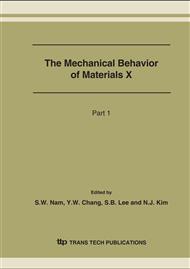p.517
p.521
p.525
p.529
p.533
p.539
p.545
p.549
p.553
Connection among the Characteristics of the Low Cycle Fatigue, High Cycle Fatigue and Fatigue Crack Growth
Abstract:
The material quality, the deformation rate, the temperature and the stress state influence mechanical behaviour and properties of different materials. Due to this great variety of the influencing factors we do not have one model of general validity describing the behaviour of materials, but we have to use a great number of material constants in order to characterize the properties. The exponents of the Manson-Coffin, the Basquin and the Paris-Erdogan laws were applied for the verification of the connection among the fatigue fracture types. Own measured values and test results can be found in the literature were used for the illustration of the connections. “Fracture surface”-s were determined for characterizing of different steel grades and their welded joints. It can be concluded that “fracture surface”-s are suitable for the describing of the fracture behaviour and the conversion of different fracture parameters of steels.
Info:
Periodical:
Pages:
533-536
Citation:
Online since:
August 2007
Authors:
Price:
Сopyright:
© 2007 Trans Tech Publications Ltd. All Rights Reserved
Share:
Citation:


